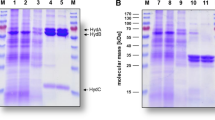Abstract
We have addressed the question, whether the reduction of caffeate in Acetobacterium woodii strain NZva16 is coupled to ATP synthesis by electron transport phosphorylation. The following results were obtained: 1. Cultures of A. woodii with H2 and CO2, grew to greater cell densities, when caffeate was also present. Caffeate was reduced to give hydrocaffeate and less acetate was formed. The cell yield based on the amount of caffeate reduced was approximately 1 g dry cells/mol. 2. Non-growing bacterial suspensions catalyzed the reduction of caffeate by H2. The specific activity (0.2–1.0 μmol · min−1 · mg−1 bacterial protein) was as high as expected for a catabolic reaction. 3. The ATP content of bacteria incubated, with H2 increased from < 1 to about 7 μmol per g cellular protein on the addition of caffeate. The ATP yield was calculated as 0.06 mol ATP · mol−1 caffeate from the initial velocity of ATP formation and the activity of caffeate reduction. Valinomycin together with nigericin inhibited ATP formation and caused a 2–3-fold increase of the activity of caffeate reduction. Protonophores were without, effect. 4. Caffeate in the presence of H2 caused the uptake of tetraphenylphosphonium cation by the bacteria. The uptake was abolished by valinomycin plus nigericin, and was considerably enhanced by monensin. Protonophores were without effect, even in the presence of monensin. It is concluded that caffeate reduction by H2 is coupled to ATP formation by electron transport phosphorylation. However, the failure of protonophores to prevent phosphorylation and TPP uptake cannot be explained.
Similar content being viewed by others
Abbreviations
- Caffeate:
-
3,4-Dihydroxycinnamate
- Hydrocaffeate:
-
3,4-dihydroxyphenylpropionate
- TPP+ :
-
tetraphenylphosphonium cation
- FCCP:
-
carbonylcyanide-4-trifluoromethoxyphenylhydrazone
- TTGB:
-
4,5,6,7-tetrachloro-2-trifluoromethylbenzimidazol
- TCS:
-
3,5,3′,4′-tetrachlorosalicylanilide
References
Bache R, Pfennig N (1981) Selective isolation of Acetobacterium woodii on methoxylated aromatic acids and determination of growth yields. Arch Microbiol 130:255–261
Bakker EP (1982) Membrane potential in a potassium transportnegative mutant of Escherichia coli K-12. Biochim Biophys Acta 681:474–483
Balch W, Schobert S, Tanner R, Wolfe R (1977) Acetobacterium, a new genus of hydrogen oxidizing, carbondioxide reducing anaerobic bacteria. Int J Syst Bacteriol 27:355–361
Bernhard T, Gottschalk G (1978) Cell yields of Escherichia coli during anaerobic growth on fumarate and molecular hydrogen. Arch Microbiol 116:235–238
Bradford MM (1976) A rapid and sensitive method for the quantitation of microgram quantities of protein utilizing the principle of protein-dye binding. Anal Biochem. 72:248–254
Dorn M, Andreesen JR, Gottschalk G (1978) Fermentation of fumarate and L-Malate by Clostridium formicoaceticum. Arch Microbiol 133:26–22
Kröger A, Winkler E (1981) Phosphorylative fumarate reduction on Vibrio succinogenes: Stoichiometry of ATP synthesis. Arch Microbiol 129:100–104
Mell H, Bronder M, Kröger A (1982) Cell yields of Vibrio succinogenes growing with formate and fumarate as sole carbon and energy sources in chemostat culture. Arch Microbiol 131:224–228
Mell H, Wellnitz C, Kröger A (1986) The electrochemical proton potential and the proton/electron ratio of the electron transport with fumarate in Wolinella succinogenes. Biochim Biophys Acta 852:212–221
Mitchell P, Moyle J (1969) Estimation of membrane potential and pH difference across the cristae membrane of rat liver mitochondria. Eur J Biochem 7:471–484
Schönheit P, Beimborn DB (1985) ATP synthesis in Methanobacterium thermoautotrophicum coupled to CH4 formation from H2 and CO2 in the apparent absence of an electrochemical proton potential across the cytoplasmic membrane. Eur J Biochem 148:545–550
Tschech A, Pfennig N (1984) Growth yield increase linked to caffeate reduction in Acetobacterium woodii. Arch Microbiol 137:163–167
Wolin EA, Wolin MJ, Wolfe RS (1963) Formation of methane by bacterial extracts. J Biol Chem 238:2882–2886
Author information
Authors and Affiliations
Rights and permissions
About this article
Cite this article
Hansen, B., Bokranz, M., Schönheit, P. et al. ATP formation coupled to caffeate reduction by H2 in Acetobacterium woodii NZva16. Arch. Microbiol. 150, 447–451 (1988). https://doi.org/10.1007/BF00422285
Received:
Accepted:
Issue Date:
DOI: https://doi.org/10.1007/BF00422285




